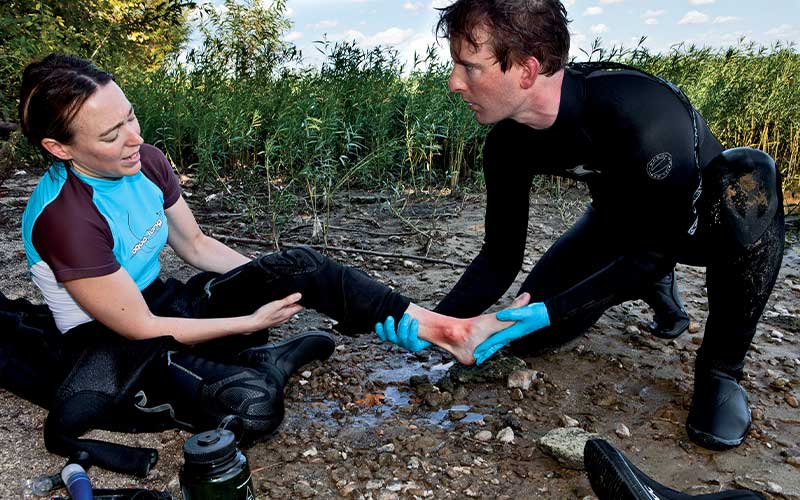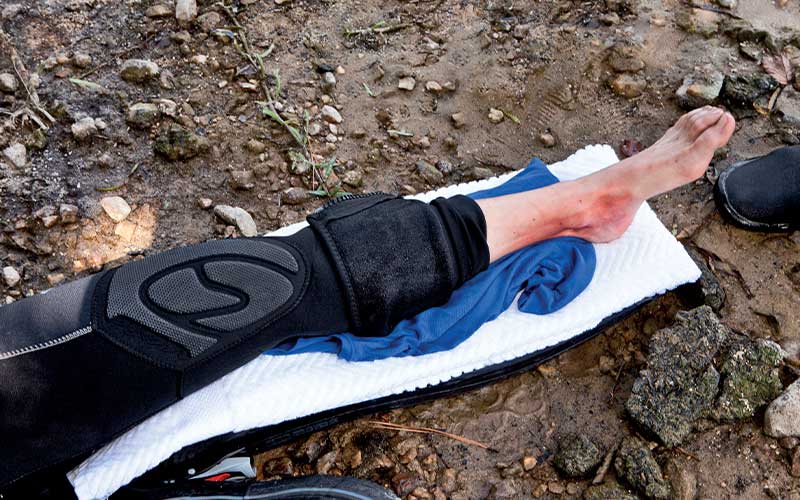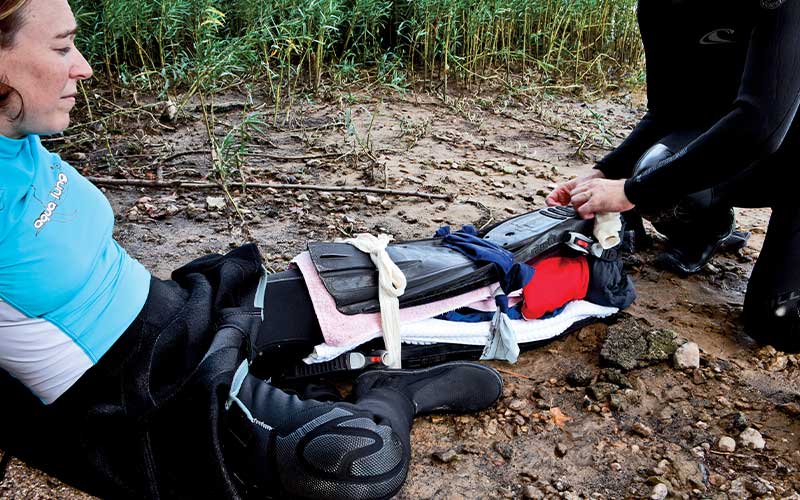As your dazed buddy reappears from the crashing surf, you can see the grimace on his face. When you make it over to him, he tells you the worst part of that last wave wasn’t the washing machine action or the unwanted high-pressure sinus rinse. It was the popping sensation from his ankle, which wedged in the coral as he was tossed by the crashing water.
Until then it had been an exciting day. The tip you received from one of your new local friends at the restaurant last night proved to be a good one. This morning you and your buddy were able to find the hidden reef you’d been hearing so much about from those in the know. It took some effort, but one cajoled cab driver, a generously-tipped pangero (guide) and a hike through the jungle later, you found paradise. The snorkeling was nothing short of spectacular, but the swim back through the breakers was rough. The tide was low, the waves were high, and the beach was a maze of rock and exposed coral when you tried to make your way ashore. Fortunately, you manage to help your buddy up onto the sand and dig out the first aid kit from your beach bag. Unfortunately, you have a hike ahead of you, and it’s looking like you won’t make your planned rendezvous with the driver.
Musculoskeletal injuries in remote environments can be especially problematic since they may greatly limit mobility. Thus, a caregiver faced with a musculoskeletal injury in the field is presented with both a medical and a logistical problem. Since specific guidelines for conducting a rescue are beyond the scope of this article, the focus will be on the medical management of these injuries.
When to Consider Evacuation
An important theme in evacuation decision-making is that it is far better for a person to depart a remote environment under his own power than it is for rescuers to have to carry him out. Transporting a person who is unable to move himself generally requires a large number of people as well as much more time and energy than may be readily apparent. With this in mind, the issue of greatest concern to a rescuer confronted with a musculoskeletal injury is usability. It is not particularly important for a caregiver in a remote environment to know exactly what type of injury has occurred. For practical purposes, distinguishing a sprain (injured ligament) from a strain (injured muscle or tendon) or a fracture (broken bone) is not necessary. The distinction that must be made is between a leg that can be walked on and one that is too injured to use.

Proper evaluation and care of a musculoskeletal, or orthopedic, injury begins with gathering information. First, look closely at the injury. Note any swelling, bruising or deformity. Next, ask the person what happened. Ask how the injury feels, how bad it is and whether he felt any unusual sensations or heard any strange sounds when it occurred. With the person’s permission, and taking care to wear gloves if bodily fluids are present, feel the injured area for things like unexpected softness or deformity. A good way to determine the extent of injury is to compare it with the uninjured side. Treat any wounds you find, and document the results of your assessment; this information may come in handy when you find yourself making decisions about how to care for the person and how and when an evacuation should take place.
As you proceed with your examination, it is important to check circulation, mobility and sensation. This is accomplished by finding a pulse (or confirming normal warmth and coloration), verifying the person’s ability to wiggle fingers or toes and confirming his ability to identify, without looking, which finger or toe you are touching. These assessments should be performed on the hand or foot distal to the injury (farther away from the heart). Checking these three functions establishes whether the injured area is properly vascularized (has adequate blood flow) and innervated (sensations are intact).
If an area shows signs of inadequate circulation, such as being cold or pale, or a pulse is absent or diminished, the person should be evacuated rapidly. This would be an appropriate criterion for using a satellite phone, if one was available, or making a mayday call to request a rescue. Lack of sensation or inability to wiggle fingers or toes in an extremity warrants similar urgency. After evaluating circulation, mobility and sensation, check the range of motion of the joint (or joints) nearest the injury. The person may hesitate to demonstrate his full range of motion because of pain, but if it seems to be truly impaired, or perhaps more concerning, if it is greatly increased, this may also be an indication that the injury is severe.
Usability

With some injuries, such as angulated fractures, usability (or lack thereof) will be obvious. Otherwise, a rescuer should take time to evaluate carefully whether the person will be able to use the injured limb. To assess usability of a lower extremity injury, for example, first encourage him to stand. Be prepared to support him if he falls. If able to stand, it is likely he will favor the uninjured leg initially, but see if he is able to distribute weight evenly between his two feet. Next, determine if he is able to place all of his weight on the injured leg, even if only for a moment. If this is accomplished, encourage him to try walking a short distance. Again, be ready to assist if he stumbles at any point. If he is successful at each of these tasks, he may be able to be an active participant in his own evacuation.
Once usability has been established, no matter the outcome of the assessment, it is helpful to take steps to reduce inflammation (swelling). This can be achieved by spending 20 or 30 minutes elevating the affected area; applying ice, a cold pack or cool water; and applying firm compression. Elevation minimizes inflammation through gravity, ice minimizes inflammation through peripheral vasoconstriction, and compression minimizes inflammation with mechanical pressure. An elastic bandage such as an Ace wrap is useful for applying compression. Anti-inflammatory medications such as ibuprofen can also help minimize swelling and relieve pain as long as there is no medical reason someone should not take a particular medication. Use medications according to the directions on their packaging.
Before a person begins to use a usably injured area, it is helpful to apply padding and support. Tape or elastic bandages help to restrict movement and reduce the likelihood of exacerbating the injury. These support mechanisms should apply firm pressure but not constrict unduly. A wetsuit, or part of a wetsuit, left in place is also a great option for providing support to a usable injury.

An injury that is not usable should be fully immobilized with a splint to minimize further injury. Splints are available commercially, but fortunately for the caregiver in the field, they can also be simple to improvise. An improvised splint should meet several key criteria: It should be well padded, rigid, adjustable and properly positioned. Significant padding is critical for comfort, and this is of great importance when one considers the length of time a person might have to wear it. Rigidity helps to limit movement and protects the injury, and adjustability allows for swelling, which is inevitable. Wetsuits, towels and clothing make excellent padding, while things like fins, BCs and snorkels can add an element of rigidity to a splint.
For injuries that appear to be on a bone, both the joint above and the joint below should be immobilized. In the case of an injured joint, the bone above and the bone below should be immobilized. Circulation, mobility of the digits and sensation in the hand or foot nearest the splint should always be verified before and after constructing a splint to ensure that nerve function or blood flow has not been impaired. These conditions should also be checked regularly as the person’s vital signs are monitored.
People who have retained function despite injury may be able to continue with the trip as planned, but they may wish to end it for reasons of comfort. Any unusable musculoskeletal injury requires examination by a medical professional, so evacuation should be initiated as soon as it is reasonably possible. If circulation, mobility of the digits or sensation is compromised, the need for evacuation is urgent. Performing a thorough assessment and utilizing available materials to support or immobilize a musculoskeletal injury can greatly improve outcomes for people who experience these injuries in remote settings.
© Alert Diver — Q4 Fall 2010